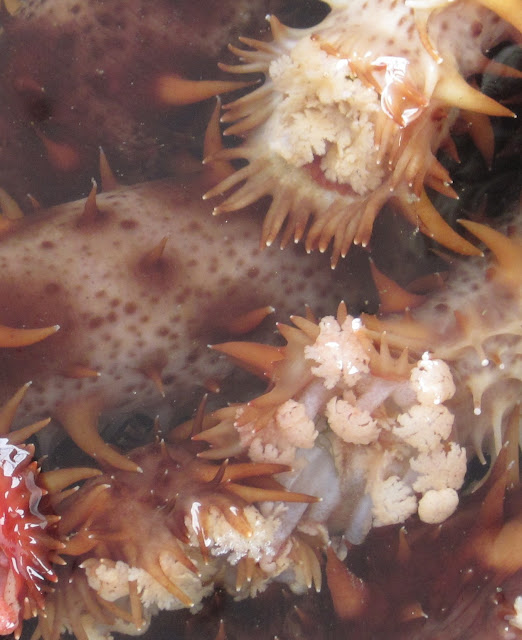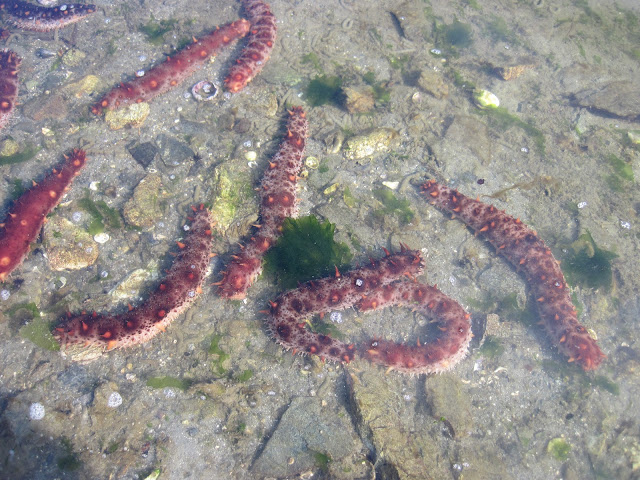Spend a little time with a sea cucumber...
...and you are sure to be dazzled.
There is so much more than meets the eye!
The first time I encountered a sea cucumber was when I was on the prowl for abalone. The tide was super low, an early morning minus tide in the summer of 1978.
I mentioned my discovery to a friend who was working in a fish processing plant. A few weeks later that friend came by for a visit and brought me a gift. She handed me a pack of cleaned, frozen sea cucumbers.
I have to admit that I pretty much wasted that pack of sea cucumbers in my attempts at cooking. Next minus tide I eagerly harvested several sea cucumbers. Again I ended up failing with the cooking. Overcooked, rubbery and tough. Cleaning and cooking sea cucumbers were both challenging and mystifying for me. Consequently, I decided to forget about sea cucumbers for a while.
Quite a few years later I came across an informative technical paper about sea cucumbers while browsing in our public library. The library had a copy machine available to patrons, so I made a copy.
You can click on images to enlarge.
My interest in sea cucumbers was renewed!
Since discovering and reading the technical paper,
I have acquired additional information about these unusual ocean creatures by way of research, observation and local knowledge.
Although more than 1500 species of sea cucumbers have been discovered in intertidal ocean waters around the world, let's focus on the most common of the species available here in Sitka and Southeast Alaska waters. Both subsistence harvesters and commercial divers target the
Red Sea Cucumber
(Apostichopus californicus)
formerly known as
California Sea Cucumber
(Parastichopus californicus)
The Alaska Department of Fish and Game issued a profile of the Red Sea Cucumber. I am including some of the information from that profile in this post along with information from the technical paper noted above.
Experienced local subsistence harvesters aren't likely to share their hot spots, but they are another great resource. Rather than learn the hard way, it saves a lot of time and frustration to learn and get advice from the experienced.
The Red Sea Cucumber is commonly found in ocean waters from the Gulf of Alaska all the way south to Baja. The sea cucumber is an echinoderm so is related to star fish and sea urchins.
There is a mouth at one end of the sea cucumber and an anus at the other end. The mouth has unusual tentacles resembling cauliflower florets!
HARVESTING
As typically happens, we were looking around in the shallows of a bay at low tide. Our giant dog, Pearl, seemed mystified as she encountered sea cucumbers.
Several of the sea cucumbers were shallow enough for us to reach down and grab hold. The cucumbers out of our reach were easily scooped up from our skiff with a long handled dip net. If gear is handy, we sometimes snorkel with a goody bag.
Wherever we have spotted a Red Sea Cucumber, there were often quite a few more nearby as seen below.
Each individual Red Sea Cucumber is not necessarily identical to surrounding cukes. The color varies including shades of red and brown with markings of black and yellow.
The size also varies. This red species of cucumber grows as large as 20 inches weighing around one pound. We always target the largest size... taking care not to harvest all of the largest from any one area.
Do yourself and the sea cucumbers a favor and don't harvest more cucumbers than you will use. And, don't harvest more than you will have time to process in the near future.
Crowding too many sea cucumbers into a bucket when harvesting will likely cause problems.
As you gather, place a sensible number inside a clean bucket with cold ocean water. We like to place no more than a dozen sea cucumbers inside a five gallon bucket filled with ocean water. (We always bring plenty of buckets along).
If the harvested sea cucumbers are injured, damaged, mishandled, slammed around or crowded, the flavor may be ruined because of a defensive toxin sea cucumbers release. If this toxin is released by sea cucumbers into the bucket water, the flavor of the entire batch may become tainted and nasty. Sea cucumbers not only are known to discharge toxins but also discharge their internal organs when sensing danger.
CLEANING SEA CUCUMBERS
We keep our sea cucumbers alive and well in cold sea water until we are prepared for processing.
Over the years we experimented with various tools. We were happiest with a simple approach. We use a knife and a cutting board of some sort. We do this work on the beach or the back deck of our boat where we can spray away any mess with a handy boat hose.
After cutting the sea cucumber from about an inch below the mouth up to the mouth, we flip it around and
Next we slice the entire underside open from one end to the other. When this is accomplished with all of the sea cucumbers we gathered, we rinse out the interiors.
For quite a few years we were inclined to utilize the interior muscles only. We would use a cutting board and slice across the layer of muscles just below the mouth.
Then we scraped the muscles away from the skin until we had enough to grab.
When held firmly, the muscle layer would then pull away from the skin. We rinsed all of the muscles well and drained in a colander. We refrigerated to cook soon thereafter or freeze.
COOKING SEA CUCUMBERS
A local subsistence harvester, Steve Johnson, wrote up and posted a useful summary last year about YEIN. YEIN is the Tlingit word for sea cucumber.
YAANUU is the Haida word for sea cucumber.
Steve wrote that his favorite methods of cooking YEIN are to sauté, fry or grill. Whichever method you choose, take care not to overcook or it will be tough to chew. My own experience to prevent overcooking, whatever the method, is to cook briefly at medium high heat. I learned over the years when cooking most any seafood it was better to risk undercooking rather than overcooking. I haven't found a way to correct overcooked food.
Below is a recipe I use for deep frying sea cucumbers.
Because I often found myself preparing meals for several family members and friends at one time, I experimented with challenging foods. So as not to overcook and ruin sea cucumbers, I tried cooking them similar to one of the methods I use for abalone.
Place the muscle meat from a dozen or so sea cucumbers (depending on how many people being served) in a blender along with an egg. Blend until it looks like pancake mix. Transfer to a bowl:
Add 2 or 3 tablespoons of flour and stir well to thicken it up a little.
Heat up an inch or two of vegetable oil in a saucepan. I prefer avocado oil. Heat to medium-hot heat around 375 degrees.
Take a good sized spoon full of the mixture and drop it into a bowl of bread crumbs:
Press and flatten it into the bread crumbs on each side. Do this 4 or 5 times. Then drop all of the 4 or 5 small patties into the hot oil. Cook them about two minutes on each side until golden brown. Lift them out onto something like a paper towel or a brown paper bag to drain any excess oil.
Repeat until you have used up all of the blended sea cucumber mix in your bowl.
Serve with favorite side dishes or salads:
DEHYDRATING SEA CUCUMBERS
After quite a few years of taking advantage of the muscle meat only, I decided to try dehydrating not only the sea cucumber muscles but also the skins. Once dehydrated and powdered with a blender, I knew the powder would be easy to incorporate into
teas, soups and other foods.
My first attempt at dehydrating was successful with the batch of muscle meat I used. After spreading the raw muscles meat out on the 14 stainless steel shelves, I chose to dehydrate them at 105 degrees. After 15 hours they were thoroughly dehydrated.
Next I intended to spread the waiting, refrigerated sea cucumber skins on the dehydrator shelves. I had trouble getting them out of the colander. They were slimy and mobile and had attempted to escape through the holes of the colander. Amazing and weird! Sections of the cucumber skins slid through the colander holes and had expanded making it difficult to pull them free.
After struggling with this a while, I remembered something I had read. I sat the entire colander in very hot water for a while, stirring a few times, to release them from the colander. People who know better first soak the skins in hot water, then dry and dehydrate. For me, this was one of those 'learned the hard way' issues I mentioned.
Once dehydrated, both the muscles and skins were easily pulsed into powder with a blender. Forty sea cucumbers produced 1/2 pint of muscle powder and a full pint of powdered skin. I kept them separated to compare the taste. Both have what I found to be a pleasant, strong, ocean flavor.
Several sources have suggested that sea cucumbers, the muscles and skins, are highly nutritious providing unusual health benefits. An article written by Laine Welch dated September 2017 in the CAPITAL CITY WEEKLY was titled:
SEA CUCUMBER COULD CURE CANCER
BABY SEA CUCUMBERS?
About ten years ago we were in a protected bay gathering some sea cucumbers in the middle of June. Up a little higher on the beach from the submerged full grown sea cucumbers were thousands of what looked like tiny baby sea cucumbers.
They were clustered among the seaweed, barnacles, mussels and rocks.
A lovely sight to see.
Over the years we have seen a good number of sea cucumbers in various protected bays. Sad to say it sounds like the numbers have declined in some locations... particularly in southern Southeast Alaska waters. Because of the reintroduction of the sea otters several decades ago and several other issues including over harvesting by humans, the decline in the numbers of sea cucumbers is not surprising. Sea cucumbers are such a delicacy!
WOULD YOU LIKE TO HARVEST SEA CUCUMBERS?
You will need to acquire an ALASKA SPORT FISHING LICENSE
if you are a resident 18 years and older or
if you are a nonresident 16 years and older.
Sport fishing for sea cucumbers with an ALASKA SPORT FISHING LICENSE enables you to gather sea cucumbers anywhere anytime without restrictions. Use any gear you choose including scuba and snorkel gear.
Without an ALASKA SPORT FISHING LICENSE, a resident is welcome to gather sea cucumbers anywhere anytime under subsistence guidelines. However, there is a restricted area in Sitka Sound where subsistence gathering of sea cucumbers is not allowed with the use of diving gear... not scuba nor snorkel gear.




























No comments:
Post a Comment